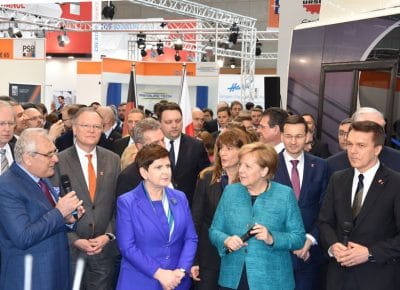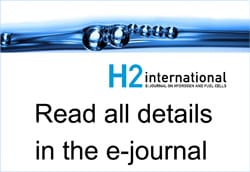
Prominent figures from industry and politics in attendance: Zarajczyk, Szydło, Merkel, Fenkl (from left)
Germany’s chancellor, Angela Merkel, sent a clear signal during her opening tour of this year’s Hannover Messe on April 24, 2017. Together with Poland’s prime minister, Beata Szydło, she went to Energy hall 27 to take a closer look at a fuel cell bus, something that created a cheerful mood among the exhibitors at the joint booth Hydrogen + Fuel Cells + Batteries set up right next to the vehicle.
To stakeholders from the fuel cell industry, the hybrid bus by Ursus – a Polish manufacturer little known in Germany at that time – was one of the high points of the trade show (see fig. 1). The engine for the vehicle with a passenger capacity of 75 and a length of 12 meters or 39 feet is located at the back axle and consists of two electric, gearless wheel hub motors (ZAwheel, 364 kilowatts) by Ziehl-Abegg, a family business from Künzelsau, Germany. By the company’s own account, their efficiency is as high as 90 per cent. Two fuel cell modules (30 kilowatts each) by Dutch-based HyMove have been installed on the roof of the bus, together with the hydrogen tank of 30-kilogram capacity. They charge the battery from German BMZ during the ride.
Peter Fenkl, CEO of Ziehl-Abegg, made one thing unmistakably clear during the chancellor’s stop: “No one needs diesel buses.” He added that German bus manufacturers might still be in the R&D stage, but that this was no reason to delay the overall implementation of fuel cell units promising a range of 450 kilometers or 280 miles (6.8 kg of H2 on 100 kilometers or 62 miles). The CEO of Ursus, Karol Zarajczyk, said: “H2 vehicles are the future of road transport. We’ve noticed an increasing demand for our hydrogen buses in western Europe. These buses are becoming ever more popular, not least because they’ve become competitive with conventional drive systems.”
…
In five days, Hannover Messe attracted 225,000 attendees – 8,000 more than in 2015 – to trade show premises boasting 6,500 exhibitors. Foreign visitors added up to 75,000, with the biggest group of 9,000 attendees coming from China. The Energy, one of the lead shows on the premises, had 1,200 organizations showcasing their products.
A bit unsettled, but hopeful
However, there was the important matter of Daimler’s alleged exit from fuel cell development (see Don’t Count on It and Daimler Stays). It was some unsettling news to the nearly 150 exhibitors and their attendees and became part of almost every conversation. But as H2-international reported, Daimler never had the intention to exit the business. Still, the rumors dampened the mood and proved yet again how unsure the industry is of its own potential. Although almost everyone we asked was visibly fed up with the repeated back and forth in the automotive industry, the mood leaned more toward the positive than the negative. We did hear statements along the lines of people needing a great deal of patience and perseverance to make it in the industry, though virtually no one in Hanover seriously questioned the viability of the technology anymore.
…
The future is on rails
Participants of the podium discussion during the press conference made precisely the same arguments. Olaf Lies, Lower Saxony’s economy minister, voiced his strong support for fuel cells and concluded that employing fuel cells in trucks and buses was a “smart move,” in addition to their use in rail vehicles. Jens Sprotte from Alstom said about railroad use: “We’re ready with the technology. It works.” And Bernd Pitschak, managing director of Hydrogenics, added: “Heavy systems in particular are predestined for fuel cell hybrid designs.” (see p. 32)
Many global players
Another memorable event was IPHE’s stop at the joint booth. Dimitrios Papageorgopoulos from the Fuel Cell Technologies Office of the U.S. Department of Energy reported on advancements overseas. One of his examples involved California, where around 1,600 FCEVs had been sold so far, a number that was expected to increase rapidly.
xperion Energy & Environment shared a booth with Norwegian-based Hexagon Composites. What had been two competitors in pressure tank sales merged into one corporation last October, albeit both brand names are said to be kept. Last year was the first in the company history of xperion, formerly part of the Avanco Group, in which it had booked a – comparatively small – booth in Hanover. This time, the Kassel-based business utilized a much bigger space, relatively in the middle of the joint booth, to exhibit its large type IV composite pressure vessels. Hexagon Lincoln, the American subsidiary of Hexagon, supplies corporations such as Daimler with hydrogen tanks for its upcoming fuel cell car, the GLC F-Cell.
As had been announced last year, Austrian-based Rouge H2 Engineering returned to the joint booth Hydrogen + Fuel Cells + Batteries. Having recently set up an office in Germany, it has designed a compact reformer unit to produce, purify and compress hydrogen (see Hanover Trade Show: Big H2 Industry Investments). The device called OSOD (On-Site On-Demand) requires gas, water and power hookups. Gernot Voitic, project manager R&D at Rouge, explained that “biogas was the fuel of choice” for this system. But even the use of natural or town gas could be eco-friendlier than the large-scale production and shipment of hydrogen used in industry, he said.
…
Sunfire had also been present on the joint booth, showcasing its electrolyzer and fuel cell developments. Asked about the relatively abrupt exit of partner Vaillant from their SOFC collaboration in March 2017, Sunfire’s CEO, Carl Berninghausen, told H2-international that he still believed it was the wrong decision. Berninghausen added that he would offer the SOFC technology developed during the project run to potential partners for it to be used as a platform to design standardized components, as had been done in other industries. Talks with Vaillant had already been ongoing.
The Energy hall
In exhibit hall 27, attendees could find businesses such as Celeroton, EMS, Flexiva, HPS (see Back to the End of the Line?), Resato and SenerTec. EMS, a German-Dutch engineering business, showed its newly developed H2 storage system at the joint booth of North Rhine-Westphalia. Equipped with a container housing a type IV pressure vessel made of a highly durable and lightweight composite material, it can store more than 1,000 kilograms of hydrogen gas at 500 bars.
Resato International, based in Assen, Netherlands, is a supplier of high-pressure vessels. It showcased a so-called H2Refuel Fleet Station, which can fill up four kilograms of hydrogen – a car tank’s worth – per hour. Its use may be limited to filing up smaller vehicle fleets overnight, but it does cost only one-tenth of conventional stations and is relatively easy to transport by forklift truck. Rob Castien, CEO of Resato, explained: “Public interest in hydrogen has grown, particularly over the past months.” One of Resato’s systems was installed by the Holthausen Group in June 2017 in Groningen, Germany, to supply hydrogen buses running between Groningen and Delfzijl in the Netherlands (see the Netherlands, next H2-international issue).
MobiliTec
Each year, it is Henning Kagermann, chair of NPE, the National Platform for Electric Mobility, who starts off the MobiliTec and presents a report on the activities of the organization. Electric transportation still has a long way to go, but Kagermann, who is also president of acatech, was optimistic and expects “exponential growth” – starting in 2020. As last year, he no longer highlighted vehicles, their technologies or the related infrastructure, but networking and automation. The trend of looking beyond the cars to smart services in data management has taken hold of the entire electric transportation industry. The head of NPE said: “The battle for the best data services has begun.”
Electric transportation: little for consumers
As in past years, the largest trade show booth on electric transportation was Baden-Württemberg’s pavilion (600 m2 or 6458 square feet; 34 exhibitors). Here, too, the most prominent topic was data platforms, apps for traffic control and automated driving. Potential buyers of electric cars had trouble finding anything of interest at the MobiliTec, except maybe for the booth of the Federal Association of Solar Mobility (see box above).
…
A young talent initiative that was now in its second year was Tec2You, for which Hydrogeit Verlag offered free HZwei issues and learning materials on hydrogen and during which more than 6,000 high-school and college students were taught about technical jobs in the industry.
Next year, Hannover Messe will take place from April 23 to 27; the 2018 partner country will be Mexico. And for the first time, the CeMAT, the world’s most important intralogistics trade show, will run parallel to Hannover Messe and every second year thereafter.


























0 Comments